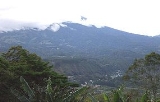
Volcán Barú
Encyclopedia
The Volcán Barú is the tallest mountain
in Panama
and is 3474 metres (11,398 ft) high. It lies about 35 km off the border of Costa Rica
.
Due to its height and Panama's relatively short width, it is possible to see both the Pacific Ocean
and Caribbean Sea
from Volcán Barú's peak on a clear day.
just south of the Continental Divide
in the western Chiriquí Province
. It is surrounded by a fertile area of cool highlands drained by the Chiriquí
and Caldera
rivers. The towns of Volcan and Cerro Punta can be found on its western side, while Boquete
is on the eastern flank.
The occasional fall of hail or ice pellets has been reported on the summit, where the minimal temperature can be below 0°C (32°F) and the formation of frost is frequent during the dry season.
occurred underneath the mountain, raising fears that it could erupt sometime in the future with explosive force.
Mountain
Image:Himalaya_annotated.jpg|thumb|right|The Himalayan mountain range with Mount Everestrect 58 14 160 49 Chomo Lonzorect 200 28 335 52 Makalurect 378 24 566 45 Mount Everestrect 188 581 920 656 Tibetan Plateaurect 250 406 340 427 Rong River...
in Panama
Panama
Panama , officially the Republic of Panama , is the southernmost country of Central America. Situated on the isthmus connecting North and South America, it is bordered by Costa Rica to the northwest, Colombia to the southeast, the Caribbean Sea to the north and the Pacific Ocean to the south. The...
and is 3474 metres (11,398 ft) high. It lies about 35 km off the border of Costa Rica
Costa Rica
Costa Rica , officially the Republic of Costa Rica is a multilingual, multiethnic and multicultural country in Central America, bordered by Nicaragua to the north, Panama to the southeast, the Pacific Ocean to the west and the Caribbean Sea to the east....
.
Due to its height and Panama's relatively short width, it is possible to see both the Pacific Ocean
Pacific Ocean
The Pacific Ocean is the largest of the Earth's oceanic divisions. It extends from the Arctic in the north to the Southern Ocean in the south, bounded by Asia and Australia in the west, and the Americas in the east.At 165.2 million square kilometres in area, this largest division of the World...
and Caribbean Sea
Caribbean Sea
The Caribbean Sea is a sea of the Atlantic Ocean located in the tropics of the Western hemisphere. It is bounded by Mexico and Central America to the west and southwest, to the north by the Greater Antilles, and to the east by the Lesser Antilles....
from Volcán Barú's peak on a clear day.
Description
Volcán Barú is a dormant, but potentially active volcanoVolcano
2. Bedrock3. Conduit 4. Base5. Sill6. Dike7. Layers of ash emitted by the volcano8. Flank| 9. Layers of lava emitted by the volcano10. Throat11. Parasitic cone12. Lava flow13. Vent14. Crater15...
just south of the Continental Divide
Continental Divide
The Continental Divide of the Americas, or merely the Continental Gulf of Division or Great Divide, is the name given to the principal, and largely mountainous, hydrological divide of the Americas that separates the watersheds that drain into the Pacific Ocean from those river systems that drain...
in the western Chiriquí Province
Chiriquí Province
Chiriquí is a province of Panama, it is located on the western coast of Panama, and it is also the second most developed province in the country, after the Panamá Province. Its capital is the city of David. It has a total area of 6,490.9 km², with a population of 416,873 as of the year 2010...
. It is surrounded by a fertile area of cool highlands drained by the Chiriquí
Chiriquí River
-References:* Rand McNally, The New International Atlas, 1993.*CIA map, 1995....
and Caldera
Caldera River
The Caldera River is a river of Panama. It passes through the town of Boquete and flows through the Volcán Barú National Park in Chiriquí Province. It flooded its banks in November , 2008. It caused extensive damage to infrastructure and many roads had to be repaired.-External links:** Boquete...
rivers. The towns of Volcan and Cerro Punta can be found on its western side, while Boquete
Boquete
Boquete is a small town on the Caldera River, tucked into the green mountain highlands of Panama, in western-most Chiriquí Province, about 60 km. from the border with Costa Rica. Because of its altitude, some 1,200 metres above sea level, its climate is cooler than that of the lowlands...
is on the eastern flank.
The occasional fall of hail or ice pellets has been reported on the summit, where the minimal temperature can be below 0°C (32°F) and the formation of frost is frequent during the dry season.
Eruption
The last major eruption of the volcano was about 500 AD. There are reports and some evidence of a minor eruption around 1550 AD. However, in 2006, an earthquake swarmEarthquake swarm
Earthquake swarms are events where a local area experiences sequences of many earthquakes striking in a relatively short period of time. The length of time used to define the swarm itself varies, but the United States Geological Survey points out that an event may be on the order of days, weeks, or...
occurred underneath the mountain, raising fears that it could erupt sometime in the future with explosive force.

